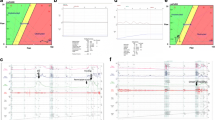Abstract
Background
Referrals to Urology OPD of men with a likely diagnosis of BPH are common.
Aims
To review referrals to OPD of men with lower urinary tract symptoms (LUTS) to establish how many could have been managed without specialist assessment.
Methods
We reviewed records of 200 male patients referred to OPD with LUTS. We assessed whether the referral source had performed digital rectal examination (DRE), International Prostate Symptom Score (IPSS), Bother Score or PSA level.
Results
74% of patients were referred by GPs. In 31.5% of cases DRE was performed prior to referral. One GP had completed an IPSS, none a Bother Score. 96% had a PSA checked before OPD. Ultimately, 88.5% of our patients were diagnosed with BPH.
Conclusions
With better pre-assessment in the form of DRE, IPSS and Bother Score, allied to a PSA check, many patients with LUTS could be managed in a primary care setting.
Similar content being viewed by others
References
Wei JT, Calhoun E, Jacobsen SJ (2005) Urologic diseases in America project: benign prostatic hyperplasia. J Urol 173(4):1256–1261. doi:10.1097/01.ju.0000155709.37840.fe
Walsh PC (2002) Surgery and the reduction of mortality from prostate cancer. N Engl J Med 347(11):839–840. doi:10.1056/NEJMe020089
Hamilton W, Sharp D (2004) Symptomatic diagnosis of prostate cancer in primary care: a structured review. Br J Gen Pract 54(505):617–621
Thompson IM, Ankerst DP, Chi C et al (2006) Assessing prostate cancer risk: results from the prostate cancer prevention trial. J Natl Cancer Inst 98(8):529–534
Babaian RJ, Miyashita H, Evans RB, von Eschenbach AC, Ramirez EI (1991) Early detection program for prostate cancer: results and identification of high-risk patient population. Urology 37(3):193–197. doi:10.1016/0090-4295(91)80283-D
Irani J, Brown CT, van der Meulen J, Emberton M (2003) A review of guidelines on benign prostatic hyperplasia and lower urinary tract symptoms: are all guidelines the same? BJU Int 92(9):937–942. doi:10.1111/j.1464-410X.2003.04529.x
Barry MJ, Fowler FJ Jr, O’Leary MP et al (1992) The American Urological Association symptom index for benign prostatic hyperplasia, The Measurement Committee of the American Urological Association. J Urol 148(5):1549–1557 (discussion 1564)
O’Leary MP (2005) Validity of the “bother score” in the evaluation and treatment of symptomatic benign prostatic hyperplasia. Rev Urol 7(1):1–10
Jepsen JV, Bruskewitz RC (1998) Comprehensive patient evaluation for benign prostatic hyperplasia. Urology 51(4A Suppl):13–18
Carballido Rodriguez J, Badia Llach X, Gimeno Collado A, Regadera Anechina L, Dal-Re Saavedra R, Guilera Sarda M (2006) Validity of tests for initial diagnosis and its concordance with final diagnosis in patients with suspected benign prostatic hyperplasia. Actas Urol Esp 30(7):667–674
Fawzy A, Fontenot C, Guthrie R, Baudier MM (1997) Practice patterns among primary care physicians in benign prostatic hyperplasia and prostate cancer. Fam Med 29(5):321–325
Quinlan MR, Teahan S, Mulvin D, Quinlan DM (2007) Is digital rectal examination still necessary in the early detection of prostate cancer? Ir J Med Sci 176(3). doi:10.1007/s11845-007-0018-x
Pedersen KV, Carlsson P, Varenhorst E, Lofman O, Berglund K (1990) Screening for carcinoma of the prostate by digital rectal examination in a randomly selected population. BMJ 300(6731):1041–1044
Kirby RS, Kirby MG, Feneley MR, McNicholas T, McLean A, Webb JA (1994) Screening for carcinoma of the prostate: a GP based study. Br J Urol 74(1):64–71. doi:10.1111/j.1464-410X.1994.tb16549.x
Casey RG, Quinlan MR, Flynn R, Grainger R, McDermott TE, Thornhill JA (2007) Urology out-patient non-attenders: are we wasting our time? Ir J Med Sci 176(4):305–308. doi:10.1007/s11845-007-0028-8
Bosch JL, Bohnen AM, Groeneveld FP (2004) Validity of digital rectal examination and serum prostate specific antigen in the estimation of prostate volume in community-based men aged 50 to 78 years: the Krimpen Study. Eur Urol 46(6):753–759. doi:10.1016/j.eururo.2004.07.019
Roehrborn CG, Girman CJ, Rhodes T et al (1997) Correlation between prostate size estimated by digital rectal examination and measured by transrectal ultrasound. Urology 49(4):548–557. doi:10.1016/S0090-4295(97)00031-9
Kaplan SA, Olsson CA, Te AE (1996) The American Urological Association symptom score in the evaluation of men with lower urinary tract symptoms: at 2 years of followup, does it work? J Urol 155(6):1971–1974. doi:10.1016/S0022-5347(01)66064-6
Flam T, Montauban V (2003) Screening of clinical benign prostatic hypertrophy in general practice: survey of 18, 540 men. Prog Urol 13(3):416–424
McGuire BB, O’Brien MF, McLoughlin S, O’Malley KJ, Fitzpatrick JM (2007) Should patients with symptomatic BPH have a trial of medical therapy by their general practitioner prior to referral for urological assessment? Ir Med J 100(4):428–429
Samaritan G, Pearlman RA (2007) Underdiagnosed and undertreated colorectal cancer tops liability list. J Med Assoc Ga 96(1):48
Verhamme KM, Dieleman JP, Bleumink GS et al (2002) Incidence and prevalence of lower urinary tract symptoms suggestive of benign prostatic hyperplasia in primary care–the Triumph project. Eur Urol 42(4):323–328. doi:10.1016/S0302-2838(02)00354-8
Bruskewitz R (1999) Management of symptomatic BPH in the US: who is treated and how? Eur Urol 36(Suppl 3):7–13. doi:10.1159/000052343
McNicholas TA (1999) Management of symptomatic BPH in the UK: who is treated and how? Eur Urol 36(Suppl 3):33–39. doi:10.1159/000052347
Author information
Authors and Affiliations
Corresponding author
Rights and permissions
About this article
Cite this article
Quinlan, M.R., O’Daly, B.J., O’Brien, M.F. et al. The value of appropriate assessment prior to specialist referral in men with prostatic symptoms. Ir J Med Sci 178, 281–285 (2009). https://doi.org/10.1007/s11845-009-0337-1
Received:
Accepted:
Published:
Issue Date:
DOI: https://doi.org/10.1007/s11845-009-0337-1




